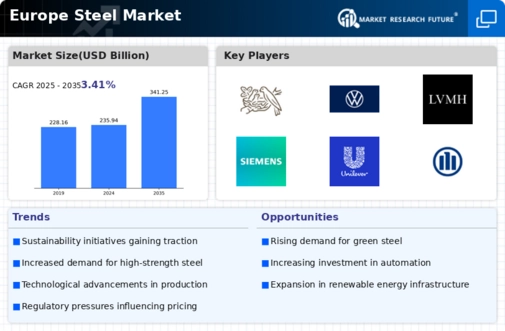The competitive landscape of the Europe Steel Market is characterized by a diverse array of players who strive to differentiate themselves through innovation, sustainability, and strategic partnerships. In this market, companies are increasingly focusing on advanced manufacturing techniques, eco-friendly production processes, and efficient supply chain management to gain a competitive edge. The dynamics of this market are influenced by evolving consumer demands, regulatory frameworks, and the overarching need for environmentally sustainable practices. Furthermore, as the European Union emphasizes carbon reduction initiatives, companies are adapting their operations to align with these objectives, thus fostering a shift towards greener steel production.
The competitive insights in this landscape reveal not only the challenges faced by established firms but also the opportunities presented by technological advancements and the growing importance of strategic alliances. Celsa Group has established a significant foothold in the Europe Steel Market, leveraging its robust production capabilities and commitment to quality. One of the key strengths of Celsa Group lies in its diverse product offerings, which include long steel products, reinforcing bars, and merchant bars aimed at various construction and industrial applications. The company has made substantial investments in modernizing its production facilities, thus enhancing efficiency and reducing costs.
Additionally, Celsa Group's strong regional presence across multiple European countries enables it to cater effectively to local demand while maintaining a competitive advantage. The emphasis on sustainability and technological innovation allows Celsa Group to not only meet regulatory standards but also align with the growing market trend towards eco-friendly steel solutions. Metinvest also plays a crucial role in the Europe Steel Market, and is recognized for its comprehensive portfolio of products and services.
This company specializes in a wide range of steel and iron products, including flat and long steel, which are essential for various sectors such as construction, automotive, and heavy industry. Metinvest's strength lies in its vertically integrated business model that encompasses mining, steel production, and distribution, ensuring high-quality control and operational efficiency. The company has a strong market presence in Europe, benefiting from strategic mergers and acquisitions that enhance its manufacturing capabilities and expand its geographic coverage.
Metinvest's commitment to sustainability is reflected in its efforts to minimize environmental impact and invest in modern technologies, positioning itself as a competitive player in the evolving European steel landscape. Additionally, the company's focus on customer requirements and its ability to adapt to market changes further solidify its position in the region.


















Leave a Comment